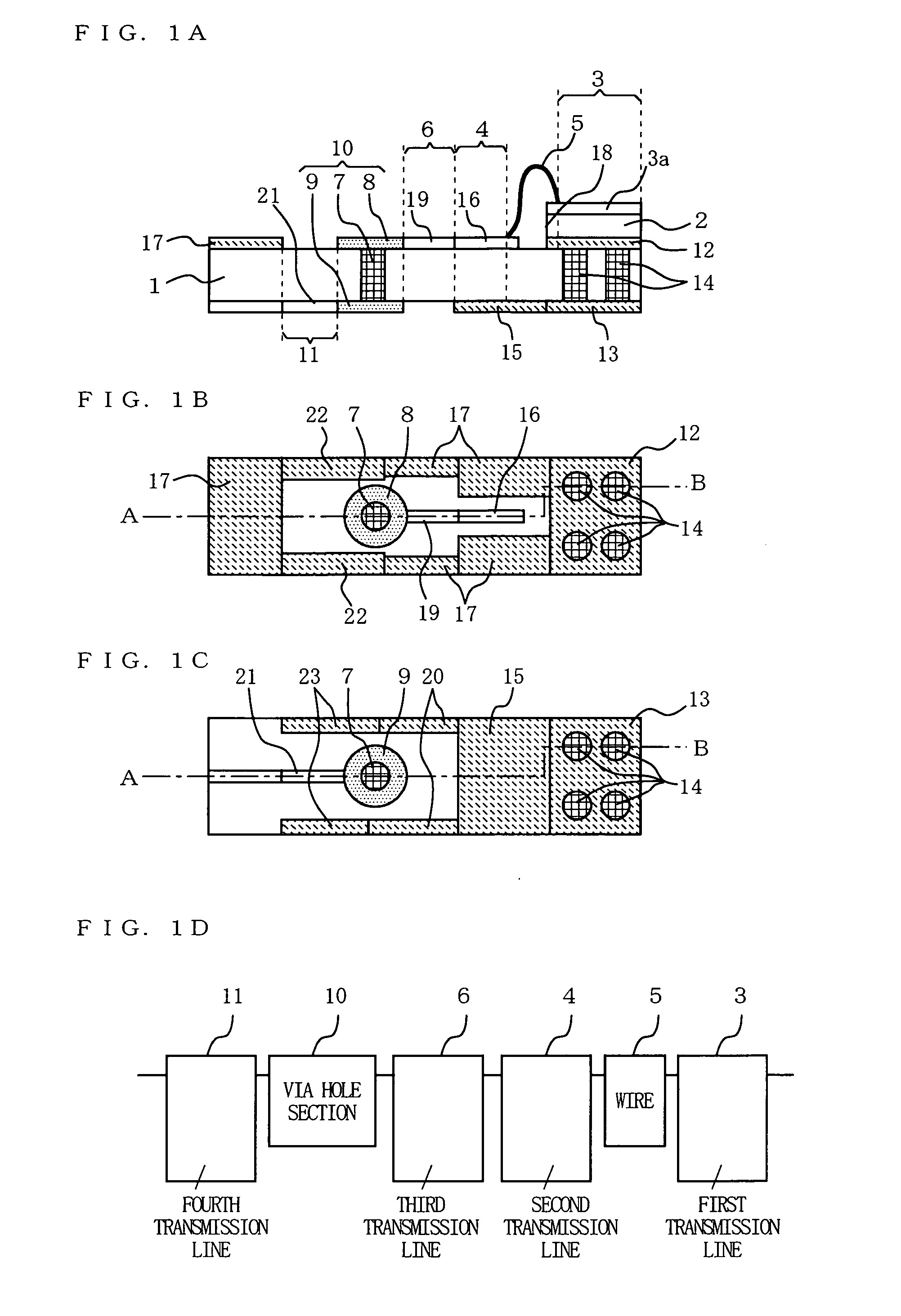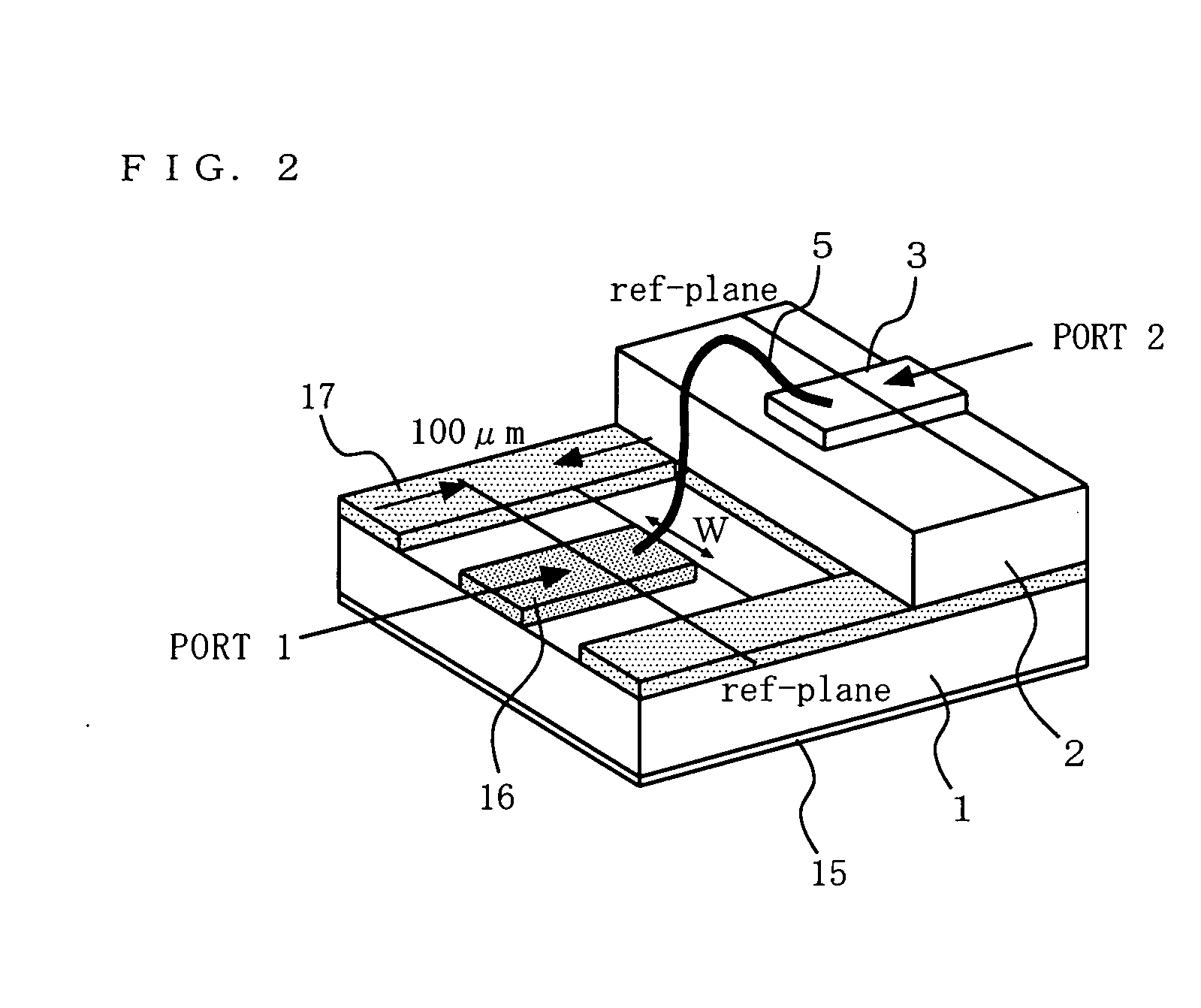High-frequency circuit
a high-frequency circuit and circuit technology, applied in the field of high-frequency circuits, can solve the problems of increasing process cost, limiting the length of the wire, and unable to obtain the characteristics typical of the high-frequency use of the semiconductor element, so as to prevent reflection at the connecting portion of the wire, the effect of low cost and enabling the effect of preventing reflection
- Summary
- Abstract
- Description
- Claims
- Application Information
AI Technical Summary
Benefits of technology
Problems solved by technology
Method used
Image
Examples
first embodiment
[0082]FIG. 1A is a schematic cross-sectional view illustrating an example of a high-frequency circuit according to a first embodiment of the present invention. FIG. 1B is a diagram illustrating a wiring pattern on a top surface of a dielectric substrate 1 shown in FIG. 1A. FIG. 1C is a diagram illustrating a wiring pattern on a bottom surface of the dielectric substrate 1 shown in FIG. 1A. FIG. 1D is a block diagram illustrating components of the high-frequency circuit according to the first embodiment of the present invention. FIG. 1A is also a cross-sectional view along lines AB of FIGS. 1B and C.
[0083] In FIGS. 1A to C, a high-frequency circuit according to the first embodiment comprises a dielectric substrate 1 and a high-frequency functional element 2. On a top surface of the dielectric substrate 1, ground conductive areas 12, 17, and 22, signal strips 16 and 19, and a top side conductive land 8 are formed. On a bottom surface of the dielectric substrate 1, ground conductive a...
second embodiment
[0122] Next, a high-frequency circuit according to a second embodiment of the present invention will be described. Components of the high-frequency circuit according to the second embodiment are the same as those for the first embodiment, and therefore FIG. 1A to D are also used here. The second embodiment is different from the first embodiment in that in at least a portion of the area of the fourth transmission line 11, the characteristic impedance is set so as to be higher than 50Ω in the second embodiment.
[0123]FIG. 10 is a diagram illustrating an equivalent circuit of a high-frequency circuit according to the second embodiment of the present invention. FIG. 10 shows a circuit configuration which is equivalent to a low pass filter of an LCLCL structure, the circuit configuration being obtained by adding, to the filter-type equivalent circuit of the CLCL structure according to the first embodiment shown in FIG. 9B, the fourth transmission line 11 (TRL4) which is set so as to have...
third embodiment
[0132] Next, a high-frequency circuit according to a third embodiment of the present invention will be described. Components of the high-frequency circuit according to the third embodiment are the same as those for the first embodiment, and therefore FIGS. 1A to D are also used here. The third embodiment is different from the first and second embodiments in that a characteristic impedance of the first transmission line 3 is set so as to be lower than 50Ω at a portion to which the wire is connected in the third embodiment.
[0133]FIG. 11 is a diagram illustrating an equivalent circuit of a high-frequency circuit according to the third embodiment of the present invention. FIG. 11 shows a circuit configuration which is equivalent to a low pass filter of an LCLCLC structure, the circuit configuration being obtained by adding, to the filter-type equivalent circuit of the LCLCL structure according to the second embodiment shown in FIG. 10, a wire connecting portion of the first transmissio...
PUM
 Login to View More
Login to View More Abstract
Description
Claims
Application Information
 Login to View More
Login to View More - R&D
- Intellectual Property
- Life Sciences
- Materials
- Tech Scout
- Unparalleled Data Quality
- Higher Quality Content
- 60% Fewer Hallucinations
Browse by: Latest US Patents, China's latest patents, Technical Efficacy Thesaurus, Application Domain, Technology Topic, Popular Technical Reports.
© 2025 PatSnap. All rights reserved.Legal|Privacy policy|Modern Slavery Act Transparency Statement|Sitemap|About US| Contact US: help@patsnap.com



